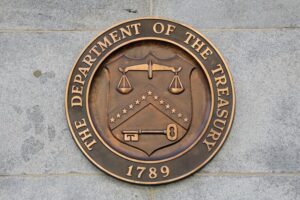U.S. Treasury Eyes Changes to Bond Auctions and Stablecoins
In a significant move for the financial markets, the U.S. Treasury Department is actively seeking input from primary dealers regarding two pressing financial topics: the use of stablecoins and potential modifications to the 20-year bond auction schedule. These discussions are set to occur during meetings on April 24 and 25, paving the way for potential changes in response to evolving market dynamics.
Understanding the When-Issued Period
The "when-issued" period serves as a crucial timeframe in bond trading, commencing after an announcement of a new security issue and concluding the day before the issuance date. During this phase, investors engage in trading activities, expressing their views on the bond’s pricing before it officially comes to market. It essentially allows the market to gauge demand and price direction prior to the bond’s issuance.
However, the current structure of the 20-year auction, which typically has an elongated when-issued period due to its mid-month announcements and settlements, has raised questions. The Treasury’s goal is to explore whether shortening this period could enhance efficiency and market liquidity, an issue particularly pertinent as investors navigate various products linked to interest rates.
The Role of Primary Dealers
Primary dealers play a fundamental role in the ecosystem of U.S. Treasury securities. These institutions act as market makers, providing liquidity and facilitating transactions in government debt. Their insights are invaluable, especially concerning estimates of budget deficits and debt issuance—a critical aspect as the Treasury prepares for its refunding announcement this May.
Currently, the 20-year auction process features a mid-month "dated date," a key factor in the calculation of accrued interest, particularly when bonds are sold between interest payment dates. This aspect becomes increasingly relevant for institutional investors and funds looking to manage their portfolios with precision.
The Intersection of Stablecoins and Treasury Securities
Amid these bond discussions, another topic is also gaining traction: the rising demand for Treasury securities as reserve assets for stablecoins. These digital currencies, which are pegged to traditional fiat currencies (typically the U.S. Dollar) to maintain price stability, have seen explosive growth in adoption among crypto traders and financial institutions alike.
With recent legislative efforts underway to establish a regulatory framework for stablecoins, including advancements within both the House and Senate, the Treasury is keenly interested in how Treasury securities might be utilized within this evolving landscape. The regulatory measures aim to create a clear environment conducive to innovation while protecting consumers and ensuring financial stability—an essential balance in the digitized economy.
Conclusion: A Dynamic Future for U.S. Treasury Securities
As the U.S. Treasury engages with primary dealers in upcoming discussions, the implications of their feedback could lead to changes that resonate through both the bond market and the burgeoning field of digital currencies. By potentially modifying the auction process and facilitating the integration of stablecoins, these measures could create new opportunities for investors while enhancing market efficiency.
Stay tuned to Extreme Investor Network for comprehensive updates on these pivotal developments in U.S. finance. We are committed to providing our readers with unique insights and analyses that empower you to navigate the complexities of investing in today’s evolving financial landscape.

